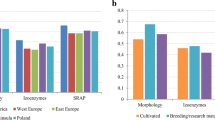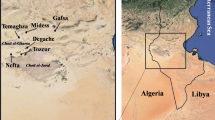Abstract
Tetraploid (2n = 4x = 40) races of Paspalum notatum Flüggé are important natural forage grasses for the tropical and subtropical areas of the Americas. Almost all natural accessions reproduce by obligate aposporous apomixis. Previous work on the species allowed the identification of several molecular markers completely linked to apospory, one component of apomictic reproduction. Moreover, after a fingerprinting characterization of a germplasm collection, 11 amplified fragment length polymorphism (AFLP) markers exclusive to apomictic accessions were detected. The objectives of this work were (1) to validate the presence of molecular markers linked to apospory in tetraploid races of different geographic origins, (2) to determine if markers specific to apomictic accessions were associated with the mode of reproduction, and (3) to develop single-locus markers of apospory that can be used for marker-assisted selection. Thirteen natural apomictic accessions were analyzed. Moreover, the parental plants Q4188 (non-aposporous) and Q4117 (aposporous) and 44 F1 progenies (36 non-aposporous, 8 aposporous) derived from them were used as a validation population. Nine markers [two random amplification of polymorphic DNA (RAPD) and seven AFLP] 100% linked to apospory in Q4117 were tested. Amplification reactions with the corresponding primers showed that all markers were present in the 13 aposporous (apomictic) accessions, but were absent in the non-aposporous controls. On the other hand, linkage analysis of the 11 AFLP markers specific to the apomictic accessions showed that all of them were linked in coupling to apospory (r = 0.00, LOD 13.245). Based on one AFLP (E36M37c), two sequence characterized amplification region (SCAR) markers (SPNA1 and SPNA2) co-segregating with the trait and present in the 13 apomictic accessions were developed. The presence of markers associated with apospory was conserved among tetraploid accessions of different geographic origins. Moreover, the single-locus markers SPNA1 and SPNA2 could be used for routine marker-assisted selection in hybrid populations segregating for apospory and to facilitate the isolation of apospory-related genes.



Similar content being viewed by others
References
Altschul SF, Gish W, Miller W, Myers EW, Lipman DJ (1990) Basic local alignment search tool. J Mol Biol 215:403–410
Brugmans B, van der Hulst RGM, Visser RGF, Lindhout P, van Eck HJ (2003) A new and versatile method for the successful conversion of AFLP-TM markers into simple single locus markers. Nucleic Acids Res 31:10e55. doi:10.1093/nar/gng055
Burton GW (1948) The method of reproduction in common bahiagrass, Paspalum notatum. J Am Soc Agron 40:443–452
Burton GW (1967) A search for the origin of Pensacola bahiagrass. Econ Bot 21:379–382
Calderini O, Chang SB, de Jong H, Busti A, Paolocci F, Arcioni S, de Vries S, Abma-Henkens MHC, Klein Lankhorst RM, Donnison IS, Pupilli F (2006) Molecular cytogenetics and DNA sequence analysis of an apomixis-linked BAC in Paspalum simplex reveal a non pericentromere location and partial microcolinearity with rice. Theor Appl Genet 112:1179–1191
Daurelio DL, Espinoza F, Quarin CL, Pessino SC (2004) Genetic diversity in sexual diploid and apomictic tetraploid populations of Paspalum notatum situated in sympatry or allopatry. Plant Syst Evol 244:189–199
Dellaporta SL, Wood J, Hicks JB (1983) A plant DNA minipreparation: version II. Plant Mol Biol Rep 1:19–21
Espinoza F, Daurelio LD, Pessino SC, Valle EM, Quarin CL (2006) Genetic characterization of Paspalum notatum accessions by AFLP markers. Plant Syst Evol 258:147–159
Forbes I Jr, Burton GW (1961) Cytology of diploids, natural and induced tetraploids, and intraspecies hybrids of bahiagrass, Paspalum notatum Flüggé. Crop Sci 1:402–406
Gates RN, Quarin CL, Pedreira CGS (2004) Bahiagrass. In: Moser LE, Burson BL, Sollenberger LE (eds) Warm-season (C4) grasses. ASA, CSSA, and SSSA, Madison, pp 651–680
Guo W, Zhang T, Shen X, Yu JZ, Kohel KJ (2003) Development of SCAR marker linked to a major QTL for high fiber strength and its usage in molecular-marker assisted selection in upland cotton. Crop Sci 43:2252–2256
Jarret RL, Ozias-Akins P, Phatak S, Nadimpalli R, Duncan R, Hiliard S (1995) DNA contents in Paspalum ssp. determined by flow cytometry. Genet Resour Crop Evol 42:242–273
Kashkush K, Khasdan V (2007) Large-scale survey of cytosine methylation of retrotransposons and the impact of readout transcription from long terminal repeats on expression of adjacent rice genes. Genetics 177:1975–1985
Lander ES, Green P, Abrahamson J, Barlow A, Daly MJ, Lincoln SE, Newburg L (1987) MAPMAKER: an interactive computer package for constructing primary genetic linkage maps of experimental and natural populations. Genomics 1:174–181
Martienssen R (1998) Transposons, DNA methylation and gene control. Trends Genet 14:263–264
Martínez EJ, Urbani MH, Quarin CL, Ortiz JPA (2001) Inheritance of apospory in bahiagrass, Paspalum notatum. Hereditas 135:19–25
Martínez EJ, Hopp E, Stein J, Ortiz JPA, Quarin CL (2003) Genetic characterization of apospory in tetraploid Paspalum notatum based on the identification of linked molecular markers. Mol Breed 12:319–327
Nogler GA (1984) Gametophytic apomixis. In: Johri BM (ed) Embryology of angiosperms. Springer, Berlin, pp 475–518
Ortiz JPA, Pessino SC, Leblanc O, Hayward MD, Quarin CL (1997) Genetic fingerprinting for determining the mode of reproduction in Paspalum notatum, a subtropical apomictic forage grass. Theor Appl Genet 95:850–856
Ortiz JPA, Pessino SC, Bhat V, Hayward MD, Quarin CL (2001) A genetic linkage map of diploid Paspalum notatum. Crop Sci 41:823–830
Ozias-Akins P, Roche D, Hanna WW (1998) Tight clustering and hemizygosity of apomixis-linked molecular markers in Pennisetum squamulatum implies genetic control of apospory by a divergent locus that may have no allelic form in sexual genotypes. Proc Natl Acad Sci USA 95:5127–5132
Ozias-Akins P, Akiyama Y, Hanna WW (2003) Molecular characterization of the genomic region linked with apomixis in Pennisetum/Cenchrus. Funct Integr Genomics 3:94–104
Paran I, Michelmore RW (1993) Development of reliable PCR-based markers linked to downy mildew resistance genes in lettuce. Theor Appl Genet 85:985–993
Pupilli F, Busti A, Quarin CL, Arcioni S (2001) The chromosome segment related to apomixis in Paspalum simplex is homeologous to the telomeric region of the long arm of rice chromosome 12. Mol Breed 8:53–61
Pupilli F, Martínez EJ, Busti A, Calderini O, Quarin CL, Arcioni S (2004) Comparative mapping reveals partial conservation of synteny at the apomixis locus in Paspalum spp. Mol Gen Genomics 270:539–548
Quarin CL (1992) The nature of apomixis and its origin in Panicoid grasses. Apomixis Newslett 5:8–15
Quarin CL, Burson BL, Burton GW (1984) Cytology of intra- and interspecific hybrids between two cytotypes of Paspalum notatum and P. cromyorrhizon. Bot Gaz 145:420–426
Quarin CL, Espinoza F, Martínez EJ, Pessino SC, Bovo OA (2001) A rise of ploidy level induces the expression of apomixis in Paspalum notatum. Sex Plant Reprod 13:243–249
Quarin CL, Urbani MH, Blount AR, Martínez EJ, Hack CM, Burton GW, Quesenberry KH (2003) Registration of Q4188 and Q4205, sexual tetraploid germplasm lines of Bahiagrass. Crop Sci 43:745–746
Rabinowicz PD, Palmer LE, May BP, Hemann MT, Lowe SW, McCombie WR, Martienssen RA (2003) Genes and transposons are differentially methylated in plants, but not in mammals. Genome Res 13:2658–2664
Roche D, Conner JA, Budiman MA, Frisch D, Wing R, Hanna WW, Ozias-Akins P (2002) Construction of BAC libraries from two apomictic grasses to study the microcolinearity of their apospory-specific genomic regions. Theor Appl Genet 104:804–812
Stein J, Quarin CL, Martínez EJ, Pessino SC, Ortiz JPA (2004) Tetraploid races of Paspalum notatum show polysomic inheritance and preferential chromosome pairing around the apospory-controlling locus. Theor Appl Genet 109:186–191
Stein J, Pessino SC, Martínez EJ, Rodríguez MP, Siena LA, Quarin CL, Ortiz JPA (2007) A genetic map of tetraploid Paspalum notatum (bahiagrass) based on single-dose molecular markers. Mol Breed 20:153–166
Vos P, Hogers R, Bleeker M, Reijans M, van de Lee T, Hornes M, Frijters A, Pot J, Kuiper M, Zabeau M (1995) AFLP: a new concept for DNA fingerprinting. Nucleic Acids Res 23:4407–4414
Xu M, Huaracha E, Korban SS (2001) Development of sequence-characterized amplified regions (SCARs) from amplified fragment length polymorphism (AFLP) markers tightly linked to the Vf gene in apple. Genome 44:63–70
Acknowledgments
The authors thank Prof. Michael Hayward, Wales, for critically reading the manuscript. Our thanks also to Florencia Galdeano for her technical assistance. This study was financed by the Agencia Nacional de Promoción Científica y Tecnológica (ANPCyT), Argentina, PICT 2007 No. 00476 and PME 2006 No. 03083; Consejo Nacional de Investigaciones Científicas y Técnicas (CONICET), Argentina, PIP 2008 No. 6805 and PIP 112-200801-01378; Centro Argentino Brasilero de Biotecnología, CABBIO 2004 No. 012. R. N. Rebozzio and M. P. Rodriguez received fellowships from CONICET. F. Espinoza, C. L. Quarin and J. P. A. Ortiz are career members of CONICET.
Author information
Authors and Affiliations
Corresponding author
Electronic supplementary material
Below is the link to the electronic supplementary material.
11032_2010_9537_MOESM1_ESM.tif
Fig. 1 Collection sites of tetraploid Paspalum notatum accessions used for validating the presence of markers linked to apospory. The grey area shows the natural distribution of tetraploid cytotypes in Central and South America (TIFF 5982 kb)
11032_2010_9537_MOESM2_ESM.tif
Fig. 2 Evaluation of SCAR markers SPNA1 and SPNA2 on natural accessions of P. notatum. Acrylamide gel showing the amplification products obtained with the forward and reverse SCAR primers on genotypes Q4188 (non-aposporous), Q4117 (aposporous), F1 Sex and F1 Apo: 3 F1 non-aposporous and 3 F1 aposporous progenies from the validation population. MW: molecular weight markers 25-bp ladder (Invitrogen). Arrows indicate the markers linked to apospory (TIFF 7507 kb)
Rights and permissions
About this article
Cite this article
Rebozzio, R.N., Rodríguez, M.P., Stein, J. et al. Validation of molecular markers linked to apospory in tetraploid races of bahiagrass, Paspalum notatum Flüggé. Mol Breeding 29, 189–198 (2012). https://doi.org/10.1007/s11032-010-9537-7
Received:
Accepted:
Published:
Issue Date:
DOI: https://doi.org/10.1007/s11032-010-9537-7




